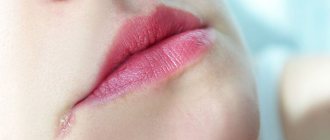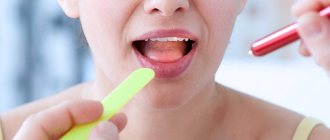Cracks in the corners of the mouth are the main symptom of angulitis. This is a disease of the mucous membrane and skin that develops under the influence of streptococci or yeast-like fungi. Diabetes mellitus, problems with bite, lack of vitamin B2 and even long-term antibiotic therapy also contribute to the occurrence of cracks. Why is the skin in the corners of the mouth prone to cracking, how to neutralize and prevent the development of the process in the future?
General characteristics of the condition
Painful cracks around the mouth are colloquially called jams. Zaeda is one of the forms of stomatitis (damage to the oral mucosa) caused by streptococci or yeast-like fungi of the genus Candida. In some cases, doctors diagnose mixed infection (angular stomatitis).
The following angulitis are distinguished: allergic (when using lipstick or other cosmetics), microbial (streptococcal, candidiasis, etc.) and post-traumatic (postoperative, post-manipulation, etc.). Microbial angulitis most often occurs in patients with diabetes mellitus (streptococcal) or in HIV-infected people (candidomycosis). Microbial angulitis in children can occur due to intestinal dysbiosis, vitamin deficiency, decreased immunity and other diseases. Post-traumatic (postoperative) angulitis is cracks in the skin and mucous membranes (linear tears in the skin or mucous membrane) in the area of the corner of the mouth, resulting from excessive (excessive) stretching after intraoral surgical dental operations (removal of dystopic or impacted wisdom teeth) or manipulations associated with treatment of wisdom teeth. Almost after every removal of an impacted or dystopic wisdom tooth, maxillary sinusotomy or other surgical interventions that require wide opening of the mouth, damage (by stretching) to the surface layers of the skin and mucous membrane in the area of the corner of the mouth occurs, i.e. post-traumatic (postoperative) angulitis.
Morphological features
Streptococcal angulitis most often develops in patients of the younger age category. First, a small bubble appears in the corners of the mouth, covered with a thin film. Later, erosion forms at the site of the bubble, covered with a crust of congealed blood and purulent masses. When the blister is opened, moist red skin with traces of minor bleeding is exposed. You can often find a crack in the center of the bubble. Approximately 1-2 hours after opening, the skin again becomes covered with a dense crust.
Content:
- General characteristics of the condition
- Possible reasons for development
- Features of therapy and prevention
Streptococcal infection of the mucous membrane is accompanied by discomfort and pain when opening the mouth.
Seizures of fungal origin are slightly different from streptococcal ones. Initially, a varnish-red erosion forms on the mucosa, surrounded by an additional layer of epithelium. Sometimes erosion is covered with a grayish coating. A specific crust does not form in case of candidiasis angulitis. Most often, the crack is masked by an overhanging skin fold and has a chronic, relapsing course.
Symptoms and photos
In adults, a crack in the corner of the mouth during its formation goes through several stages. Initially, bubbles or nodules form in the corner of the mouth (see photo above). Bacteria penetrate the skin and mucous membrane of the oral cavity, and are accompanied by the following symptoms:
- burning around the mouth,
- itchy sensations,
- pain when opening the mouth,
- wet discharge from mothers-in-law,
- swelling of the affected area,
- an unpleasant feeling of tightness.
During this period, any movement of the lips (smiling or chewing food) can provoke rupture of the skin, resulting in the formation of cracks. Afterwards, the skin may begin to peel or become covered with a crust (plaque). With even slight movement of the lips, tears form, and this is accompanied by pain.
A crack caused by streptococcal fungal infection can lead to deep tears (even bleeding).
Difference from herpes
Seizures are divided into certain types depending on the initial cause of their appearance, which is easiest to determine at the second stage of development of the pathology - when the crusts have not yet appeared, but there is already a crack itself and discharge from it.
Visually, at the third stage of development, it is almost impossible to distinguish it from herpes. So how are these two diseases different?
- The appearance of herpes is caused by the presence of a herpes infection in the body. Jams can be the result of many infections, fungi, and even mechanical damage, which subsequently becomes infected from the outside.
- Herpes appears around the mouth on the lips, under the nose and on other parts of the body. Seizures appear exclusively in the corners of the mouth.
- Herpes looks like many small sores that develop into one large wound. The jam starts directly from the cracks.
- Herpes, if left untreated, can grow in any direction, making the person want to constantly scratch around the affected area. Seizures can spread further only as a result of constant mechanical damage to the skin, and this again occurs through cracks.
Since seizures and herpes are activated at moments of weakness of the human body, they are often combined into one affected area. It all starts with a banal seizure and continues with herpes. This happens very often. Therefore, it is better to visit a doctor and find out “what exactly” needs to be dealt with and with what drugs.
Herpes
Possible reasons for development
The appearance of a jam indicates not only infection or internal pathological processes, but also the bad habits of the person himself. Regularly licking your lips is a ritual that some people find extremely difficult to break. It is important to understand that regular exposure to saliva, which contains billions of bacteria, has a detrimental effect on the mucous membranes. If a crack has already formed, licking the lips interferes with regeneration and further fuels the infection.
Neglecting the rules of personal hygiene is also fraught with the development of cracks in the corners of the mouth. Possible causes include: microtraumas, lack of cleansing, dirt on the skin.
Eating in childhood most often indicates iron deficiency anemia. Therefore, all pediatricians advise immediately taking a blood test for iron, and not sinning on problems with the baby’s hygiene. The main thing is not to try to correct anemia on your own. Introducing meat and pomegranates in large quantities into the diet can only maintain the existing iron level, but not increase it. Noticed symptoms of anemia? Go to the doctor and undergo a comprehensive therapeutic course.
Cracks in the corners of the mouth can also be a symptom of:
- vitamin B2 deficiency;
- malocclusion;
- missing teeth or incorrectly selected dentures;
- allergic lesions of the oral cavity;
- caries;
- metabolic disorders;
- long-term treatment with strong medications.
What you need to know about chronic recurrent binge eating?
In some cases, therapy gives a short-term effect or does not affect the condition of cracks in the corners of the mouth at all. For frequently recurring seizures, the doctor must conduct a comprehensive diagnosis of the body, identify and eliminate the root cause. What diseases can chronic angulitis indicate?
- HIV. A weakened body becomes easy prey for pathogenic microbes. Most often, cracks cannot be treated, and the surrounding skin becomes covered with a white coating, becomes dry and inflamed.
- Tuberculosis, chronic infectious pathologies. Microtraumas occur due to fungus or mixed flora. Often, recurrent seizures are accompanied by increased night sweats and sudden changes in body temperature.
- Intestinal diseases. Failure of the functionality of the gastrointestinal tract is always associated with disruption of metabolic processes. Intestinal diseases impair the absorption of nutrients, including iron and B vitamins. The lack of these nutrients provokes a decrease in the protective function of the mucous membrane and the development of cracks.
- Diabetes. In diabetes mellitus, an imbalance of mucosal microorganisms occurs. Moreover, by-products of impaired glucose metabolism accumulate in tissues. The result is microtrauma of tissue with a characteristic white coating, which is hidden behind skin folds.
- Oncological diseases. Cancer suppresses the body's protective functions and consumes the lion's share of nutrients, which can lead to a lack of micro- and macroelements and anemia. Recurrent seizures may well be a symptom of a tumor in the oral cavity or gastrointestinal tract.
How to treat lip jams
Before we move on to consider how Levomekol helps with jams in the corners of the mouth, we will recommend some options that will allow you to treat jams before they become inflamed. Moreover, in this way, both adults and children will be able to help themselves.
- Give up bad habits, carefully follow all the rules of hygiene, and then the jams simply will not appear or, if they already exist, they will begin to heal much more quickly.
- There is no need to eat salty, sour or spicy foods.
- Also, do not eat sweet foods, because this is the favorite habitat of mushrooms.
- Eat as many vegetables as possible, as well as dairy products made from natural raw materials.
- Refrain from using lipstick, foundation, or other cosmetics, because this can spread germs all over your face, and this is not necessary now.
In order to prevent seizures, hygienic lipstick will come in handy, especially if the weather outside is windy. Honey, rose oil and flax are also great ways to moisturize your skin. It is also necessary to take into account that if you want to cure seizures quickly and effectively, you do not need to comb the affected areas and, of course, apply an ointment like Levomekol.
Features of therapy and prevention
Best materials of the month
- Coronaviruses: SARS-CoV-2 (COVID-19)
- Antibiotics for the prevention and treatment of COVID-19: how effective are they?
- The most common "office" diseases
- Does vodka kill coronavirus?
- How to stay alive on our roads?
Therapy is based on eliminating the root cause of the seizure, but there are also general recommendations for caring for the affected skin. If the cracks are streptococcal in nature, ointments with antibiotics are additionally administered, and if they are fungal, ointments with an antifungal effect are administered. The skin around the crack must be regularly treated with disinfectant solutions to avoid re-development of the source of infection. After eliminating the root cause, therapy continues for another 7-10 days until the skin is completely restored.
Depending on the root cause of angulitis, the course of treatment may include the use of antibiotics, B vitamins or paraffin-based ointments. In most cases, the prognosis is favorable. The main thing is not to self-medicate, consult a doctor in a timely manner and follow all necessary recommendations.
Levomekol as a good remedy against seizures
Levomekol is a very good remedy, its action is somewhat similar to Panthenol. The ointment can effectively fight germs and cure seizures. Moreover, many who have used Levomekol say that in just three days you can solve this problem if you smear the affected areas two to three times a day.
Improvement occurs the very next day, however, you need to take into account that there may be a bitter taste in the mouth, but for the sake of an excellent result you can tolerate it. Doctors also recommend using Levomekol ointment for seizures. At the same time, there are no special contraindications to the use of Levomekol. There may only be slight itching, hives and reporting. But all this very rarely happens.
This medicine Levomekol is inexpensive, you can buy it at any pharmacy, in addition, this drug is available without a prescription. In order for recovery to occur as quickly as possible, lubricate the corners of your mouth with ointment as often as possible, the ideal option would be three or even four times a day. After this, refrain from eating food and hot drinks. Everyone who has used Levomekol ointment for sticking on their lips highly recommends it.
Sources:
Vidal : https://www.vidal.ru/drugs/levomecol__1655 GRLS : https://grls.rosminzdrav.ru/Grls_View_v2.aspx?routingGu >
Found a mistake? Select it and press Ctrl + Enter
Angulitis, which is popularly called seizures, is considered by many to be a childhood disease, but this is far from the case.
Such painful wounds, covered with a dry crust and located in the corners of the mouth, also occur in adults, just less frequently than in children. When a seizure occurs, many people try to mask it using various cosmetics, which should not be done, as this leads to a worsening of the condition.
At the initial stage, the disease is asymptomatic, and only in rare cases a small bubble of liquid may appear at the site of the future wound. More often, a person realizes that he is sick only at the moment when, due to unexpectedly formed ulcers and cracks on the skin, it becomes painful to eat and speak. Any opening of the mouth begins to be accompanied by pain of varying intensity.
To treat seizures, both medications and folk remedies can be used with high efficiency.
Useful video about treatment of seizures
| Ointments can be applied to the corners of the lips and surrounding areas of the skin in a thin layer, but a better effect can be achieved with ointment compresses. To do this, the medicine is applied to a sterile napkin and fixed in the corners of the lips with an adhesive plaster overnight. Antibacterial ointments are ineffective against fungal infections; moreover, they can aggravate the course of candidiasis. |
| Antifungal agents (fungicides): |
| Antifungal ointments are used by applying them to the corners of the mouth in a thin layer or in the form of compresses 3-4 times a day. |
| Antibacterial agents: |
| Ointments can be applied to the corners of the lips and surrounding areas of the skin in a thin layer, but a better effect can be achieved with ointment compresses. To do this, the medicine is applied to a sterile napkin and fixed in the corners of the lips with an adhesive plaster overnight. |
| Combined ointments: |
| Combined ointments contain an antibiotic, an antifungal component and a glucocorticosteroid hormone. |
| Remedies that promote rapid healing of a seizure: |
| In order to quickly get rid of jams, in addition to antibacterial ointments and antiseptics, use ointments that promote wound healing. But you need to know that these ointments are not prescribed from the first day of therapy. They are connected to the main treatment when the first positive results appear: on the 2-4th day. |
Seizures in the corners of the mouth: treatment with ointments
At home, when seizures occur, antiseptic, antibacterial, antifungal and combination ointments are used, depending on the pathogen. Antibacterial and antifungal agents are more effective than antiseptics, since they not only prevent the proliferation of microorganisms, but also contribute to their death. Good results can be achieved by combining solutions and ointments.
Below are the TOP 5 types of ointments for treating seizures at home:
| Name of ointment | Description |
| Ointments with antiseptic effect: |
- Sulfur-salicylic-zinc ointment;
- Salicylic ointment;
- Sulfuric ointment;
- Zinc ointment;
- Metrogil;
- Balsamic liniment (Vishnevsky ointment).
Prescribed for the following cases: common and uncomplicated streptococcal and candidal infections.
Levomekol ointment is not suitable for treatment in the lip area. Oxolinic ointment and Acyclovir are ineffective against streptococcal and candidal infections.
- Soda solution (1 tsp soda per 200.0 ml of water);
- Candide solution;
- Fucis DT – lozenges;
- Fucis gel;
- Holisal;
- Nystatin ointment;
- Lamicon cream;
- Lamisil cream;
- Levorin ointment and others.
Prescribed for the following cases: candidal infections.
Fungicide solutions are used to treat not only the corners of the mouth, but also the entire oral cavity. This is necessary for the treatment or prevention of candidal stomatitis.
Fungicides are ineffective against streptococcal infections.
- Tetracycline ointment;
- Erythromycin ointment;
- Gentamicin ointment;
- Streptocide ointment;
- Syntomycin ointment;
- Baneocin ointment;
- Bactroban;
- Fusiderm cream.
Prescribed in the following cases: streptococcal seizures
Antibacterial ointments are ineffective against fungal infections; moreover, they can aggravate the course of candidiasis.
Levomekol ointment is not suitable for treatment in the lip area. Oxolinic ointment and Acyclovir are ineffective against streptococcal and candidal infections.
- Triderm;
- Trimistin;
- Lorinden S and others.
Prescribed for the following cases: chronic seizures; seizures caused by mixed infection; in the presence of concomitant atopic dermatitis in the area around the mouth.
These remedies can only be prescribed by a specialist when other treatment methods do not help.
- Bepanten ointment;
- Sea buckthorn oil;
- Oil solutions of vitamins A and E, Aevit;
- Panthenol.
Prescribed in such cases: all types of jam.
Healing ointments are applied in a thin layer 3-4 times a day at least an hour after using antibacterial ointments.
Usually, seizures do not require general treatment; they heal with the use of only local medications. But if the lesions have spread to large areas of the skin, do not heal for a long time and are associated with immunity problems, then the use of general remedies is necessary. They are prescribed only by a doctor.
Causes
In adults, seizures usually appear during the cold season, when the activity of metabolic processes in the body decreases. One of the predisposing factors is the presence of chronic somatic diseases, which are characterized by seasonal exacerbations. A weakened immune system leads to increased activity of opportunistic microflora.
The immediate cause of seizures due to decreased immunity are:
- bacteria (mainly streptococci);
- yeast-like fungi of the genus Candida;
- viral infection (most often the herpes virus).
Prevention
The occurrence of seizures can be prevented by following the following recommendations:
- If seizures bother you quite often, you need to undergo a full examination. Perhaps the cause of the disease is hidden in the body.
- Monitor the condition of your mouth and teeth. Get a timely preventive examination from your dentist. Caries, tartar, poor-quality dentures - all this can contribute to the appearance of angulitis.
- Proper nutrition will help get rid of an unpleasant disease. The diet should contain foods rich in vitamins B2, C, E.
- Carry out timely vitamin therapy. But it is worth remembering that hypervitaminosis can also cause seizures.
- There is no need to allow your lips to become dry or flaky. To moisturize, use hygienic lipstick, thermal water, wax, honey, oils (linseed, rose, coconut).
Ksenia
when I encountered jams, the wound did not heal for a long time, then the pharmacy advised me to use the drug Aftofix, you apply it, rub it with a damp finger and you get a protective film, thanks to which the wound heals faster and eating is not so painful.
What are jams?
Seizures or angular stomatitis are any inflammation in the mouth area, both inside and outside. When it comes to inflammation in the corners of the mouth, it is correct to call this condition angular cheilitis. It looks like redness in the area, possibly with painful crusting or blistering and bleeding.
Seizures occur in people of all ages, but each age group has its own reasons for their occurrence. For example, in older people, seizures occur due to wearing dentures, in younger people - due to a lack of vitamins or immunodeficiency. In children, bumps appear for other reasons and therefore they require special skin care products.








